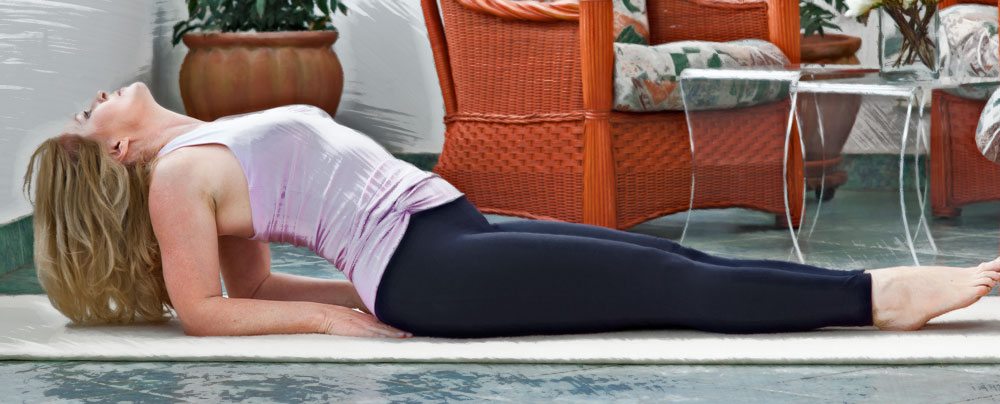Steps for Starting a Yoga Practice At Home

The growing demands on our lives in conjunction with technology’s ability to make us accessible 24/7 can leave us feeling overwhelmed and chronically stressed. This is one of the many reasons starting a yoga practice at home is important and worth implementing into your life.
Yoga is a mind-body practice that supports slowing down and taking time to tune into the breath amidst the chaos of our lives. This slowing down process triggers the parasympathetic nervous system, otherwise known as the relaxation response, and runs directly counter to the fight-flight-freeze response so commonly associated with chronic stress. Additionally, yoga helps to cultivate cardiovascular strength, flexibility, and stamina. If you are a new student interested in starting a yoga practice to dial down the stress or are just attracted to the multitude of benefits that yoga has to offer, starting your yoga practice at home can be simple with the use of online yoga videos. Other online yoga classes are out there. New students should look for an online streaming service that offers a variety of styles, especially classes that are tailored to the beginner. Along with finding the right online service, here are 5 easy steps for starting a yoga practice at home for beginners.
5 Steps for Starting a Yoga Practice At Home
Step 1: Gain clarity on the importance of starting a yoga practice
For beginners learning how to do yoga at home, it is important to get quiet and reflect on why it is important to start a yoga practice. What is it about the practice that attracts you?
Perhaps you have heard about its benefits, both psychological and physical. Or, maybe you are looking to live a more balanced life with contentment, ease, and less reactivity and feel that the practice can help support you along this path. Get clear and set intentions about what it is you hope to derive from your practice. This clarity on your “values” around starting a yoga practice will provide a solid foundation upon which to move toward your practice, and guide and support you on the journey.
Step 2: When and where to do your home practice
Get clear with what works best for you in terms of when to do your practice (e.g., morning versus evening), and the location. Life can get in the way.
So, psychologically, it is optimal to set realistic goals and take “baby steps” as you work your way towards these goals. So, for example, it might be best to set a goal of doing a 20-minute practice for at least 3 days/week for a month. Stay with this goal for one month before thinking about increasing the amount of time or frequency of your practice. With respect to location, find a quiet space if possible where you will have little to no interruptions (e.g., kids, animals). And, have your yoga mat, towel, blanket, block, and any other props you might need readily available. Try to make this location your sacred space for the practice.
Step 3: Practice basic yoga poses
Basic yoga poses form the building blocks for your practice. They are key to both cultivating and sustaining a home practice.
Therefore, you will want to choose poses that you feel attracted to. Basic yoga poses, when done with intention and mindfulness and without judgment or evaluation, can be just as challenging if not more than the more “advanced” yoga poses. Examples of basic poses include fish pose, cat-cow, downward-facing dog, child’s pose, cobra, and plank position. An online streaming service that offers classes tailored to yoga at home for beginners is a great resource for providing instruction on how to practice these poses with pictures to guide the new student.
Step 4: Commitment, commitment, commitment
How do you lay the foundation to stay committed to your practice, even when you feel low, lethargic, or tempted by the many other priorities that eat up your time on a daily basis?
Think about the other commitments you have going on in your life and reflect on how you were able to develop commitment towards these projects. It may also be worthwhile to reflect on why starting a yoga practice is important to you. Get clear about whether you are being guided by your ego, or by something that truly provides meaning in your life.
Step 5: Patience, self-compassion, and flexibility
It is nice to approach your home practice with patience, self-compassion, and flexibility.
Without these two aspects, the hard days when you are feeling run down and overwhelmed will leave you feeling worse. Have patience when setting up your home practice and remain diligent, even during turbulent times. This especially comes into play when not feeling connected to your practice. For example, maybe you find that you are falling out of balancing poses more often than you would like. Practice self-compassion for similar times, and find joy in the challenge that can come with staying grounded and connected with each breath as you move through the asanas—just you alone on the mat with your breath. Flexibility comes into play when you have set a schedule, get into a comfortable groove with that schedule, and feel like you finally “got it.” Then, something comes up to throw you off balance, as is typical of life’s tendency for turbulence. These are the times when flexibility is paramount. Allow yourself the space to make changes to your schedule, and practice self-compassion during the times you get off track. If you are unable to practice on any given day, make it up on a different day. And, be okay with the shift in schedule.
